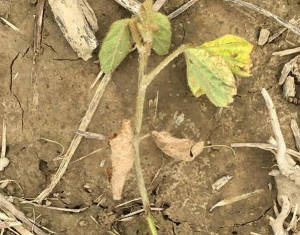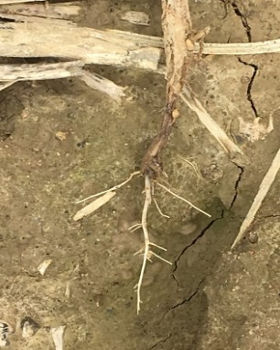By Anne Dorrance
A month or summer’s worth of rain has fallen in many areas of Ohio in June – and we aren’t even finished planting. Many fields that were planted were under water last week. Fortunately, the sunny weekend, (finally) kept the waters moving so the plants may be set back a bit. Symptoms of seedling blight and root rot typically begin a week after these rains, but flooding injury is going to be very apparent in the next few days as the warm temperatures hit many fields.

Wilted yellow seedling
Under these conditions, flood injured plants will wilt, but if the roots were not infected, they will recover in a few days as new roots begin to form. Once these plants are removed the soil and the roots can breathe again, they will form new secondary roots and the plants will recover. You can collect some of these symptomatic plants, wrap the roots in a damp paper towel for a couple of days and then see if new roots grow or the plants continue to decline.

Root cortical tissue is missing and roots are white
Another key symptom to differentiate between flood injured and root rots is the color of the center of the root, the root stele in botanical terms. On flood injured plants the outside rows of cells die and can be easily pulled off, leaving almost a mouse tail appearance to the roots (Figure 1). A root rot from Pythium, Phytophthora, Fusarium will turn brown and sometimes soft and easily crushed. Flooding injury, even on a young seedling, the root stele is still tough, almost like a toothpick. I am expecting the reports of root rots to start soon, but we had good seed treatment packages on most of the seed, and much of these rains fell during the time period that those fungicides should have been active. This is what I have observed in our own studies to date but more time will tell.
Flooding can be very severe, where substantial ponding occurred there are no plants at all and the field smells. This is where the carbon dioxide built up and basically smothered every living thing including plants. The best advice for these fields – give some more time before you look at them. The cool nights predicted for the coming week will give the plants that are just injured to recover, and then you will know if it was a disease or just an injury.
Source: osu.edu